
Hormizd-Ardashir, better known by his dynastic name of Hormizd I, was the third Sasanian King of Kings (shahanshah) of Iran, who ruled from May 270 to June 271. He was the third-born son of Shapur I, under whom he was governor-king of Armenia, and also took part in his father's wars against the Roman Empire. Hormizd I's brief time as ruler of Iran was largely uneventful. He built the city of Hormizd-Ardashir, which still remains a major city today in Iran. He promoted the Zoroastrian priest Kartir to the rank of chief priest (mowbed) and gave the Manichaean prophet Mani permission to continue his preaching.

Hormizd II was king (shah) of the Sasanian Empire. He ruled for seven years and five months, from 303 to 309. He was a son and successor of Narseh.

Hormizd III, was the seventeenth king (shah) of the Sasanian Empire, ruling briefly from 457 to 459. He was the son and successor of Yazdegerd II. His reign was marked by the rebellion of his younger brother Peroz I, who with the aid of one of the Seven Great Houses of Iran, the House of Mihran, and the eastern neighbours of the Sasanians, the Hephthalites, had him captured and executed.

Bahram I was the fourth Sasanian King of Kings of Iran from 271 to 274. He was the eldest son of Shapur I and succeeded his brother Hormizd I, who had reigned for a year.

Bahram II was the fifth Sasanian King of Kings (shahanshah) of Iran, from 274 to 293. He was the son and successor of Bahram I. Bahram II, while still in his teens, ascended the throne with the aid of the powerful Zoroastrian priest Kartir, just like his father had done.

Bahram IV, was the Sasanian King of Kings of Iran from 388 to 399. He was likely the son and successor of Shapur III.
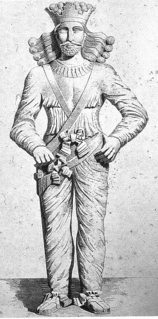
Shapur I was the second Sasanian King of Kings of Iran. The dating of his reign is disputed, but it is generally agreed that he ruled from 240 to 270, with his father Ardashir I as co-regent until the death of the latter in 242. During his co-regency, he helped his father with the conquest and destruction of Arab city of Hatra, whose fall was facilitated, according to Islamic tradition, by the actions of his future wife al-Nadirah. Shapur also consolidated and expanded the empire of Ardashir I, waged war against the Roman Empire and seized its cities of Nisibis and Carrhae while he was advancing as far as Roman Syria. Although he was defeated at the Battle of Resaena in 243 by Roman emperor Gordian III, he was the following year able to win the Battle of Misiche and force the new Roman Emperor Philip the Arab to sign a favorable peace treaty that was regarded by the Romans as "a most shameful treaty".

Shapur III, was the Sasanian King of Kings of Iran from 383 to 388. He was the son of Shapur II and succeeded his uncle Ardashir II.

Ardashir II, was the Sasanian King of Kings of Iran from 379 to 383. He was the brother of his predecessor, Shapur II, under whom he had served as vassal king of Adiabene, where he fought alongside his brother against the Romans. Ardashir II was appointed as his brother's successor to rule interimly till the latter's son Shapur III reached adulthood. Ardashir II's short reign was largely uneventful, with the Sasanians unsuccessfully trying to maintain rule over Armenia.
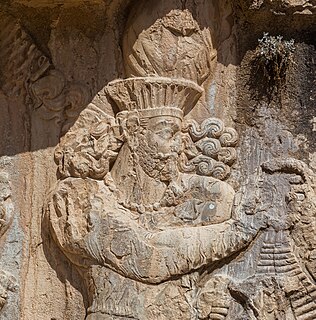
Narseh was the seventh Sasanian King of Kings of Iran from 293 to 303.

Naqsh-e Rostam is an ancient archeological site and necropolis located about 12 km northwest of Persepolis, in Fars Province, Iran. A collection of ancient Iranian rock reliefs are cut into the face of the mountain and the mountain contains the final resting place of four Achaemenid kings notably king Darius the Great and his son, Xerxes. This site is of great significance to the history of Iran and to Iranians, as it contains various archeological sites carved into the rock wall through time for more than a millennium from the Elamites and Achaemenids to Sassanians. It lies a few hundred meters from Naqsh-e Rajab, with a further four Sassanid rock reliefs, three celebrating kings and one a high priest.

Kartir was a powerful and influential Zoroastrian priest during the reigns of four Sasanian kings in the 3rd-century. His name is cited in the inscriptions of Shapur I and the Paikuli inscription of Narseh. Kartir also had inscriptions of his own made in the present-day Fars Province. His inscriptions narrates his rise to power throughout the reigns of Shapur I, Hormizd I, Bahram I, and Bahram II. During the brief reign of Bahram II's son and successor Bahram III, Kartir was amongst the nobles who supported the rebellion of Narseh, who overthrew Bahram III and ascended the throne. During Narseh's reign, Kartir fades into obscurity, due to not doing anything noteworthy as high priest.

Khosrow III was a Sasanian rival claimant who briefly ruled a part of Khorasan for a few months in 630.
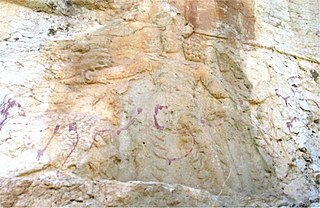
Sar Mashhad is a village in Dadin Rural District, Jereh and Baladeh District, Kazerun County, Fars Province, Iran. At the 2012 census, its population was 3,047, in 623 families.

Shapur I's Ka'ba-ye Zartosht inscription, also referred to as The Great Inscription of Shapur I, and Res Gestae Divi Saporis (RGDS), is a trilingual inscription made during the reign of the Sasanian king Shapur I after his victories over the Romans. The inscription is carved on the Ka'ba-ye Zartosht, a stone quadrangular and stepped structure located in Naqsh-e Rustam, an ancient necropolis located northwest of Persepolis, in today's Fars Province, Iran. The inscription dates to c. 262.

Hormizd I Kushanshah was Kushanshah of the Kushano-Sasanian Kingdom from 275 to 300. His reign was marked by his rebellion against his brother and suzerain the Sasanian King of Kings Bahram II.
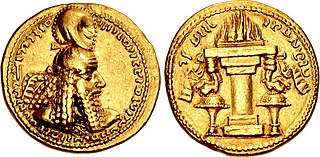
Sasanian coinage was produced within the domains of the Iranian Sasanian Empire (224–651). Together with the Roman Empire, the Sasanian Empire was the most important money-issuing polity in Late Antiquity. Sasanian coinage had a significant influence on coinage of other polities. Sasanian coins are a pivotal primary source for the study of the Sasanian period, and of major importance in history and art history in general. The Sylloge nummorum Sasanidarum is the most important primary work of reference for Sasanian coins.
The Temple of Anahita was an ancient fire temple in Istakhr dedicated to the worship of the Iranian goddess Anahid.
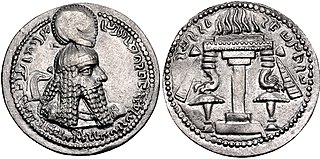
The Korymbos was a jewel-studded globe containing the top hair of the ruler of the Sasanian dynasty of Iran, resting on his crown. It was introduced by Ardashir I. The art historian Matthew P. Canepa notes that although the Greek word Korymbos or Latin Corymbus has become a scholarly convention to refer to the spherical shape on the top of Sasanian crowns, it is not an indigenous Iranian term.

















